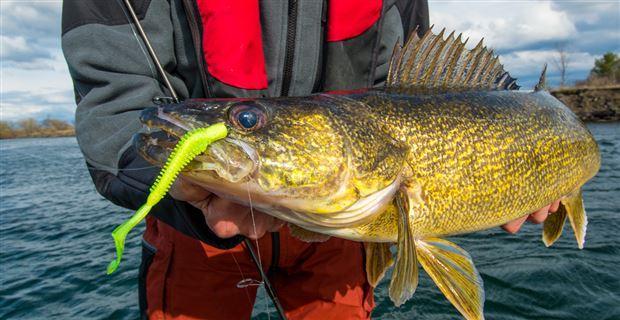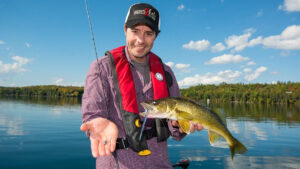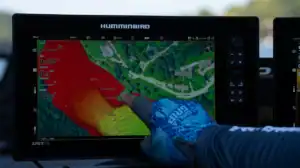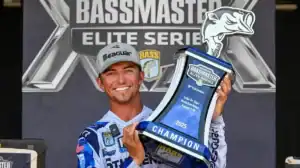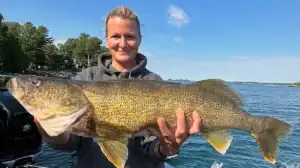A drop-shot presentation catches big walleyes. Yet, many anglers still haven’t tried it. Simple and versatile, a drop shot is easy to fish and will hook walleye relating to the bottom of lakes, rivers and reservoirs. The rig is a reliable finesse presentation for fussy ‘eyes, but it does more. A big bait on a drop shot appeals to aggressive fish. Spring to fall, walleye can rarely resist the vulnerable appeal of a drop shot whether it’s cast, drifted or fished vertically.
Here are 5 points explaining why and how to fish a drop shot for walleye:
- Bait and weight separation
- Versatile tactic
- Top baits
- Rigging details
- Don’t overwork it
Bait and weight separation
One strength of a drop shot is its weight dangles on a tag end below the hook. This creates the following advantages:
- Excellent action – An unweighted bait falls slowly on slack line and moves naturally when twitched with light rod moves. These actions are useful for teasing bites from fickle walleye.
- Natural feel – There’s little resistance when a walleye initially takes an unweighted drop-shot bait. This helps turn nibblers into biters.
- Going heavy – Once on bottom, a heavy weight doesn’t impact a bait’s appeal. This allows a 1/2-ounce weight, or heavier, to be used to maintain bottom contact in deep water or strong current.
- Info probe – The rig’s constant bottom contact sends vibrations up the line. When these change, it’s often the giveaway of a bottom transition, which commonly attracts walleye.
- Bypass grass – Grass, chara and algae grow on sand and soft-bottom flats where walleye hunt perch and baitfish. Keeping a jig clean while maintaining a finesse presentation can be tricky. A drop shot with a long tag end does this easily. It raises the bait above clingy plants and stays visible to prowling fish.
Versatile tactic
A drop shot catches walleye in rivers, lakes and reservoirs. These areas offer prime drop-shot opportunity.
Classic structure – Fishing a drop shot vertically over rocky reefs, humps, secondary points and other bottom contour changes catches walleyes tucked in among rocks or hugging ledges. The rig is equally good for casting, provided snags aren’t too bad. A drop shot works anywhere a jig does, sometimes better.
Flats – Flats are food shelves for walleye. A drop shot isn’t the best search bait, but when you know fickle walleye are around, it’s a good choice.
Fan cast the flat with the rig. Lightly shake and drag it. Maintain bottom contact with the weight. Adding a pause often triggers a bite. Use a steady to brisk retrieve to cover water. When a spot produces a walleye, cast back to it as there’s likely more fish around.
Vegetation edges – Pitching a drop shot along a weed edge or beside clumps catches walleye. Make a short cast and let the rig touch bottom. Shake and pause it a few times. This attracts fish. Work the rig back to the boat or, if weed growth is thick and irregular, reel in and pitch to the next section.
Timber – A drop shot is an option when walleye are holding in the shade of standing timber or laydowns along deep shorelines. A thin bait sinks straight down and won’t spiral, which is best when probing wood.
Use a light weight for a slow fall. This gives walleye suspending in the shadows time to see and grab the bait.
Drop shot baits for walleye
Usually, 3 to 4 1/2-inch baits work well for drop-shotting walleye. The following are reliable offerings:
- Finesse worm – Walleye love thin baits. From wispy tails to stockier profiles, an undulating plastic worm consistently catches fish. The Roboworm 4 1/2-inch Fat Worm has fooled walleye many times during tough bites in my boat.
- Leeches – Black, brown or olive soft-bait leeches swim seductively and are another finesse option.
- Minnows – Forked tail and tapered tail minnows are reliable baits. Paddle tail minnows also work. One angler I know catches walleye pitching a 3 1/2-inch white, Berkley PowerBait Ripple Shad around deep vegetation. The tail’s thumping vibration calls out fish tucked under the canopy.
- Bulky baits – A beefier bait appeals to active walleye. Goby profiled baits are a good option. I’ve had success, casting and dragging a B Fish N Tackle’s Moxi, which has a fat ringworm body with a long, curly thumper tail
- Live bait – I use artificial baits 95 percent of the time, but a real minnow, leech or worm on a drop shot can be a skeleton key for lock-jaw walleye.
Rigging details
Fishing a drop shot for walleye’s straightforward, but attention to detail catches anglers more fish. Consider the following aspects:
Rod and line – A medium-light to medium power spinning rod with a soft tip is best for drop-shotting walleye. A technique-specific rod helps, but isn’t mandatory. Walleye rods designed for rigging crossover well for drop-shotting. Choose 6-pound to 8-pound fluorocarbon for most scenarios.
Rigging – Most walleye baits team well with 1, 1/0 or 2/0 sized drop-shot hooks. This is tied using a palomar knot.
Nose hooking is a good all round choice for the best action with a finesse plastic. However, when walleye are stealing baits, threading a 1/4 inch to 1/2 inch of the bait onto the hook shank boosts durability. The bait must be straight. This rigging can reduce action, but it saves baits. This method helped my buddies and I conserve our soft-bait supply during a 5-day, fly-in trip to northern Quebec, and the walleye weren’t the wiser to this rigging approach.
Ditch twist – Line twist sabotages drop shot rigs. Proper rigging and not overworking a bait reduces spin. Tying in a small swivel a foot or so above the hook is another option.
Using a drop-shot hook with a no-twist design is equally effective. Sample products include the Gamakatsu Swivel Shot G-Finesse Hook, Mustad KVD Zero Twist Shot Hook and VMC Spinshot Dropshot Hooks.
Tag length trials – Experiment with tag lengths to determine the depth where walleye are eating. If sonar reveals fish off bottom, start with a tag end around 28 inches. An 8 inch to 18 inch tag works for less active fish. Belly-to-bottom walleye typically require a 4 inch to 7 inch tag. There are no hard-and-fast rules, though, so experiment.
Don’t overwork it – Giving a bait too much action is a common mistake when drop-shotting. Light rod shakes combined with periods of slack line to allow the bait to fall are all it takes to tempt a walleye to bite. When fishing in current, it’s even easier. Get the rig to bottom and let the flow dance the bait.
A popular finesse option for bass, a drop shot is just as potent for walleyes. Learning this technique will pay off. It’s versatile, easy to fish and some days, it’s a better tool for catching walleyes than traditional tactics.
Here’s a great video on the drop shot technique. While it’s bass centric, the information is incredibly usefull to walleye anglers as well.
